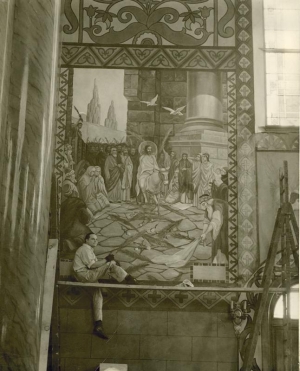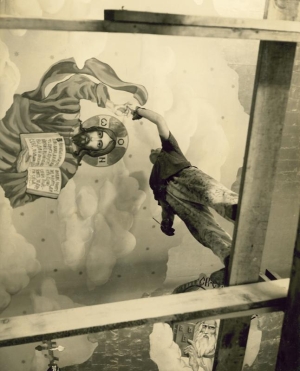|
Personal Writings
Artists Statement My art has always been about relationship; my relationship to the surrounding landscape, and to individuals, family, friends and partnerships. My art is also an expression of introspective exploration. Through art I am seeking to understand myself, who and what I am, not only as a result of these outer relationships. How am I affected and thusly produce art that embodies this transformation and understanding? My parents escaped from Russia during the Bolshevik revolution. Upon arrival in New York, my father became a major muralist during the 1930's and 40's, and a surrealist painter. He passed away when I was seven years old, and a few years later, my mother followed. Growing up without parents during the feminist revolution profoundly affected my work, and I attempted to unravel various ways of relating through sculpture. I was blessed that family art remained with me as an inspiration to realize inner feelings through visuals, painting, and color. Icons have influenced my expressions, both literal and metaphorical. In my childhood household, Russian icons with lighted candles were found in almost every room. I spent time in the churches my father painted with murals across the ceiling and walls reminiscent of Michelangelo. The icons of the 1950's were cowboys, Superman, Wonderwoman and Popeye, which inspired me to investigate how and why these archetypes have such a great effect on us and our culture. As a person who visualizes in three dimensions, my creative output is primarily executed in sculpture. Much of my work has been produced from recycled stock. My first experience with steel was as a custom car designer and builder and I use these same techniques of sandblasting, welding and painting in my metal art. I work both in extremely durable material such as bronze and steel as well as "ephemeral" material such as earth, pine needles, leaves, river stone, fallen tree branches, and straw; "nature's discards'. In more recent years I developed an extensive body of ceramics, both fragile and permanent. My use of impermanent materials has led to a deeper respect for the human body. In creating my polychrome welded steel sculptures I seek to create the illusion that they are not actually made with the durable technique of welding and reinforcing metal. By layering numerous undercoats, grounds and pigments on steel (or ceramic) I seek to mimic skin, muscle, and body mass. This is supported by a strong skeletal "bone" structure. Two years ago I was faced with the delicate, ephemeral nature of the human body first hand. Health complications resulted in the loss of my left leg. Through art I am exploring this journey and developing new ways of working. This loss has led me to a state of retrospection as well, and I am revisiting some of my original creations in bronze and steel. |
|
Recollections of My Father: Eugene Andrew Zaikine Lying in a crib in Rego Park, Long Island, N.Y. in the borough of Queens, I seem to remember a giant Rabbit eating a carrot over my bed. This would be the first of many murals my dad would do that I was a part of. Whether the recollection is true or seeing photographs of me as a baby with the grand and wise rabbit triggered those early memories I cannot say for sure.
Now, as an artist of forty seven years myself, I have experienced similar painful situations in my own life including The Korean and Vietnam Wars, and the crisis in The Middle East, as well as many personal and emotional experiences. I think my dad, through his art work, purged those feelings, emotions and sufferings of humanity, by painting them. Like Diego Rivera and Freda Kahlo, who painted and reflected their life, the heroism, my father was able to sustain by expressing how and what he felt and saw, giving him the ability to create deeply cleansing work. Thus the art that he produced acted as deep therapy and healing on many levels, which the work continues to reflect. Working on the 1939-1940 World's Fair in Flushing at Flushing Meadow Park was a high point. We went on walking trips on the formal grounds, which were torn down after the fair. Only a handful of buildings remained: The Pylon and Giant Globe Sphere in The New York City Building which is a Museum now. The land was also used temporarily as barracks for returning military personnel and their families. These buildings were also taken down by the early 1950's.
I lost him early, he was not yet forty two when he died in 1949, but his memory lives in the work that he did. Eugene Dunkel, the scenic designer, also employed my dad for his murals and was a great supporter of my dads. Dunkel gave my father high praise and many commissions that still exist in someone's house, restaurant, church or building today, bringing joy and pleasure to their viewers.
Blessing on my dad, p.s. As far as business was concerned, it was my mother, Valentina, who not only encouraged him to continue his work but could have been one of the first people displaying his art and selling outdoors. She would carry her husband's art on the subway and display it in Washington Square on the park benches whenever the weather was good. I recall one incident as a young child of about five when my mother asked my dad if after several weeks of working on a Metropolitan Church if he had gotten paid. He told her that the priest said he needed to by fixtures for the church instead of paying him and that in time he would. Without missing a beat, my mother put on a scarf and coat and was gone. Several hours later she returned with the payment in her hands. My mother had the priest open the collection box, where funds were kept in case of emergencies, to pay my father. My father had worked tirelessly, decorating this church for hours, which was now complete, in order to support his young family. This is just one example. Time and time again I witnessed such great valor from my mother. |
 At about the age of three, we moved to Saunders Street in Elmhurst, where my dad was already a sought after painter (Surrealist) and muralist. He had, to his credits, worked on many restaurants, theatre lobbies and churches through out the country. He had worked on such famous places as the Half Moon Hotel in Brooklyn, N.Y., The Mayflower Hotel in Plymouth, M.A., and The Russian Greek Catholic Cathedral of Transfiguration in Brooklyn, N.Y., The Russian Orthodox Church in Nashua, New Hampshire.
At about the age of three, we moved to Saunders Street in Elmhurst, where my dad was already a sought after painter (Surrealist) and muralist. He had, to his credits, worked on many restaurants, theatre lobbies and churches through out the country. He had worked on such famous places as the Half Moon Hotel in Brooklyn, N.Y., The Mayflower Hotel in Plymouth, M.A., and The Russian Greek Catholic Cathedral of Transfiguration in Brooklyn, N.Y., The Russian Orthodox Church in Nashua, New Hampshire.
 Then there was his humorous side. An active magician in The Black Stone Fellowship of Magic, he had this uncanny ability to pull rabbits out of hats at a moments notice. So metaphorically speaking, with pencil and paint brush or pen, Surrealism would give way to humor, black humor at its highest form.
Then there was his humorous side. An active magician in The Black Stone Fellowship of Magic, he had this uncanny ability to pull rabbits out of hats at a moments notice. So metaphorically speaking, with pencil and paint brush or pen, Surrealism would give way to humor, black humor at its highest form.